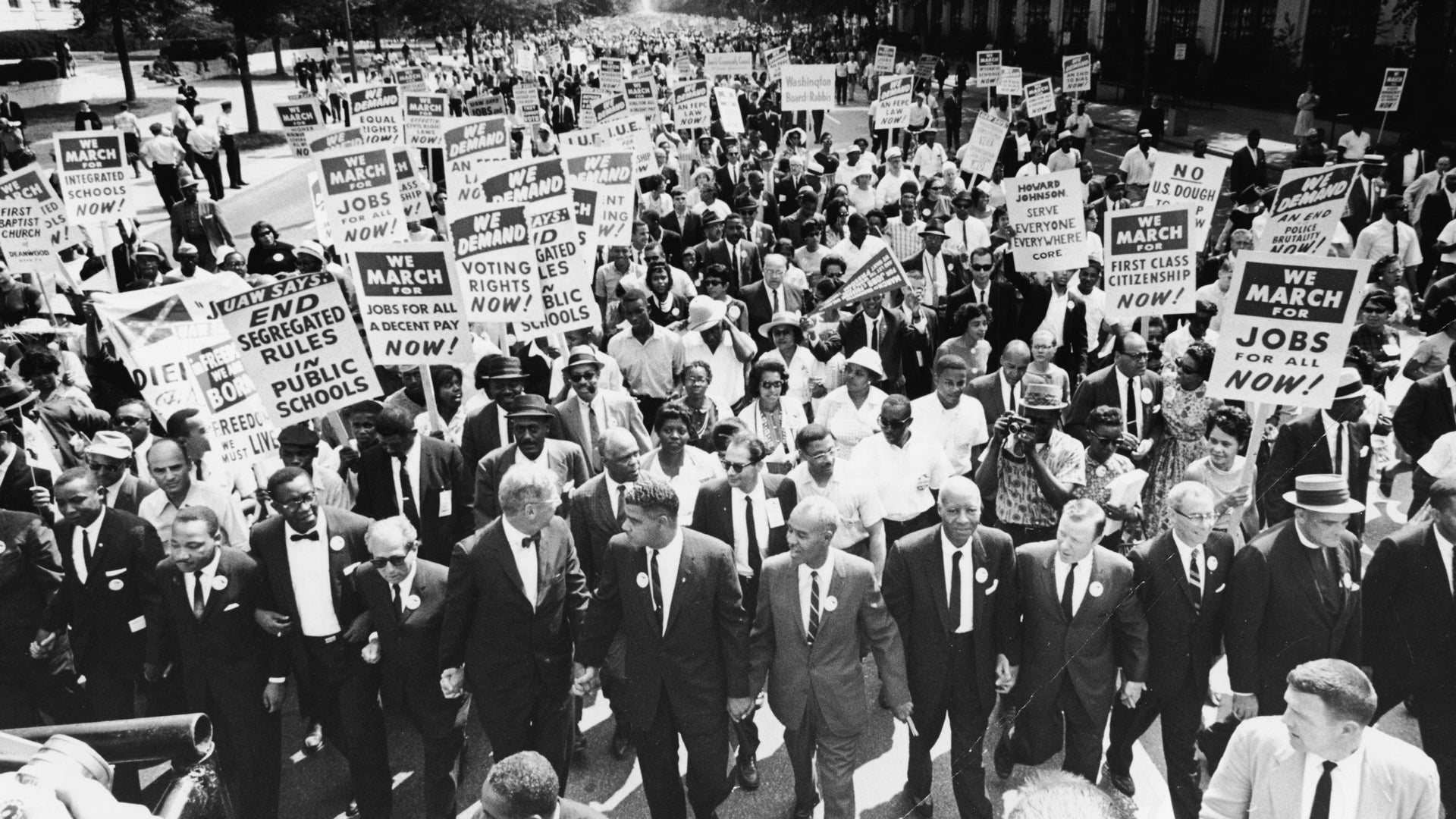The civil rights movement, a significant turning point in American history, commenced in the mid-1950s and endured through the 1960s. This transformative movement emerged as a response to the deep-seated racial injustices that permeated various aspects of society. Marked by impassioned protests, landmark court cases, and charismatic leadership, the civil rights movement aimed to dismantle racial segregation, promote equality, and safeguard the rights of African Americans.
The seeds of the civil rights movement were sown on December 1, 1955, in Montgomery, Alabama. On that fateful day, an African American woman by the name of Rosa Parks refused to give up her seat on a segregated bus to a white passenger, thus igniting a spark that would galvanize a nation. This courageous act of defiance against the prevailing system of racial segregation sparked a 381-day boycott of Montgomery’s bus system, led by a young Baptist minister named Martin Luther King Jr. Parks’ refusal to surrender her dignity fueled a nascent movement that would soon blaze a trail across the country.
As the 1960s dawned, the civil rights movement gained momentum and visibility. Activists organized sit-ins, such as the Greensboro sit-ins in 1960, to protest racial segregation at lunch counters and other public spaces. These nonviolent protests aimed to confront and expose the discriminatory practices that marginalized African Americans. The growing movement called for an end to racially biased laws and practices and advocated for equality in employment, education, voting rights, and housing opportunities.
In 1963, the civil rights movement reached a pivotal moment with the March on Washington for Jobs and Freedom. It was during this momentous event that Martin Luther King Jr. delivered his iconic “I Have a Dream” speech, capturing the imagination and aspirations of millions. This watershed moment reinforced the movement’s commitment to nonviolent resistance and galvanized public support for the cause.
Perhaps the most impressive triumph of the civil rights movement came in 1964 with the passage of the Civil Rights Act. This groundbreaking legislation outlawed racial segregation in public places, protected voting rights, and prohibited employment discrimination based on race, color, religion, sex, or national origin. The Civil Rights Act embodied the collective effort of countless activists, community leaders, and ordinary citizens who fought tirelessly to reshape the landscape of American society.
While the civil rights movement reached its apex during the 1960s, its impact reverberates to this day. It served as a catalyst for subsequent movements advocating for the rights of other marginalized groups, such as women, the LGBTQ+ community, and individuals with disabilities. The struggle for equality and justice remains an ongoing endeavor, showcasing the enduring legacy of the civil rights movement.
In conclusion, the civil rights movement took root in the 1950s, gained momentum throughout the 1960s, and forever transformed the fabric of America. Its inception, fueled by Rosa Parks’ refusal to yield, propelled the fight against racial segregation and discrimination. Through nonviolent demonstrations, groundbreaking legislation, and powerful leaders like Martin Luther King Jr., the civil rights movement effectively challenged the status quo and paved the way for a more inclusive and equitable society.
More About : When Did The Civil Rights Movement Start
Introduction:
The Civil Rights Movement, a pivotal moment in American history, emerged as a response to systemic racial discrimination and oppression experienced by African Americans. Spanning from the late 1950s to the late 1960s, this movement aimed to challenge racial segregation, fight for equality, and enforce suffrage rights. This blog post will explore the key events and influential figures that shaped the Civil Rights Movement, ultimately leading to significant legislative reforms and social progress.
I. The Roots of Injustice:
A. Prolonged Slavery: The blog post will highlight the historical context of slavery in America, illustrating how it laid the foundation for racial inequality and injustice that persisted beyond its abolition.
B. Plessy v. Ferguson Case: The post will discuss the landmark Supreme Court ruling in 1896, which legalized racial segregation by establishing the “separate but equal” doctrine.
II. Precursors to Change:
A. Early Activism: The blog will examine the contributions of figures such as W.E.B. Du Bois and Booker T. Washington, who laid the groundwork for future civil rights activism through their writings and advocacy.
B. NAACP Formation: The post will highlight the creation of the National Association for the Advancement of Colored People (NAACP) in 1909, an organization dedicated to combating racial discrimination.
III. The Montgomery Bus Boycott:
A. Rosa Parks: The blog post will introduce Rosa Parks, a civil rights activist whose refusal to give up her seat on a segregated bus triggered the Montgomery Bus Boycott in 1955.
B. Martin Luther King Jr.: The post will explore the prominent role played by Martin Luther King Jr. in leading the boycott, emphasizing his charismatic leadership and commitment to nonviolent protest.
IV. The Sit-In Movement:
A. Greensboro Sit-In: The blog post will discuss the iconic Greensboro sit-in of 1960, where four African American college students staged a peaceful protest at a segregated lunch counter, igniting similar demonstrations across the country.
B. Rise of SNCC: The post will highlight the significance of the Student Nonviolent Coordinating Committee (SNCC) in mobilizing young activists and amplifying their voices in the fight for equal rights.
V. March on Washington:
A. Historic Event: The blog will detail the 1963 March on Washington for Jobs and Freedom, where over 250,000 protestors gathered to demand civil rights reforms, culminating in Martin Luther King Jr.’s iconic “I Have a Dream” speech.
B. Legislative Impact: The post will explore how public pressure generated by the march ultimately led to the passage of the Civil Rights Act of 1964 and the Voting Rights Act of 1965.
VI. Legacy and Its Impact:
A. Changing Public Opinion: The blog will discuss how the Civil Rights Movement forever altered public perception, fostering a greater awareness of racial discrimination and prompting societal change.
B. Continuing Struggles: The post will also acknowledge that while significant advancements were made, systemic racism still persists, underscoring the importance of ongoing activism.
Conclusion:
The Civil Rights Movement began as a response to racial injustice in the United States and sparked a nationwide shift in attitudes toward equality. Taking readers through the pivotal events of the movement, from the Montgomery Bus Boycott to the March on Washington, this blog post aims to educate and inspire, emphasizing the power of collective action in effecting meaningful change. By acknowledging how far society has come since those turbulent times while recognizing the work still to be done, readers are encouraged to reflect upon the ongoing importance of championing civil rights and standing up against discrimination.
FAQs on When Did The Civil Rights Movement Start
Q: When did the civil rights movement start?
A: The civil rights movement in the United States began in the mid-1950s.
Q: What were the main goals of the civil rights movement?
A: The main goals of the civil rights movement were to secure equal rights and opportunities for African Americans and end racial segregation and discrimination.
Q: Who were the key figures of the civil rights movement?
A: Some key figures of the civil rights movement include Martin Luther King Jr., Rosa Parks, Malcolm X, and Thurgood Marshall.
Q: What were some significant events that marked the civil rights movement?
A: Significant events that marked the civil rights movement include the Montgomery bus boycott in 1955, the March on Washington for Jobs and Freedom in 1963, and the Selma to Montgomery marches in 1965.
Q: What were some landmark legislations passed during the civil rights movement?
A: Landmark legislations passed during the civil rights movement include the Civil Rights Act of 1964, which outlawed discrimination based on race, color, religion, sex, or national origin, and the Voting Rights Act of 1965, which aimed to protect the voting rights of African Americans.
Q: How did the civil rights movement affect segregation?
A: The civil rights movement played a crucial role in dismantling segregation by challenging discriminatory laws and demanding equal treatment under the law for all citizens.
Q: Did the civil rights movement solely focus on racial equality?
A: While racial equality was a primary focus of the civil rights movement, it also sought to address discrimination based on other factors such as gender, nationality, and religion.
Q: How did the civil rights movement impact society today?
A: The civil rights movement left a lasting impact on American society by paving the way for greater equality and opportunities for marginalized groups, inspiring future social movements, and laying the foundation for progressive legislation.
Q: Were there any setbacks or challenges faced during the civil rights movement?
A: Yes, the civil rights movement faced several setbacks and challenges, including violent opposition, resistance from white supremacist groups, and the assassination of key leaders like Martin Luther King Jr.
Q: Is the fight for civil rights still ongoing today?
A: Yes, the fight for civil rights is an ongoing struggle to ensure that all individuals, regardless of their race or background, are treated fairly and have equal rights and opportunities in society.




